The Best Indoor Vining Plants to Help You Embrace Nature Indoors
Adding a little bit of color to your home can be as easy as finding an indoor plant. But with so many different breeds and types of plants, you may not be quite sure where to start. There are flowering plants, dwarf shrubs, and so many more.
If you are considering adding a vining plant to your home, you are not alone. They make for a great addition to any room because they are quite small with long vines. There are a huge array of options, too. Lots of philodendrons, grape ivy, string of heart/pearl/dolphin/bananas, hoya carnosa and compacta, monstera variations, and so many others.
1. Pothos
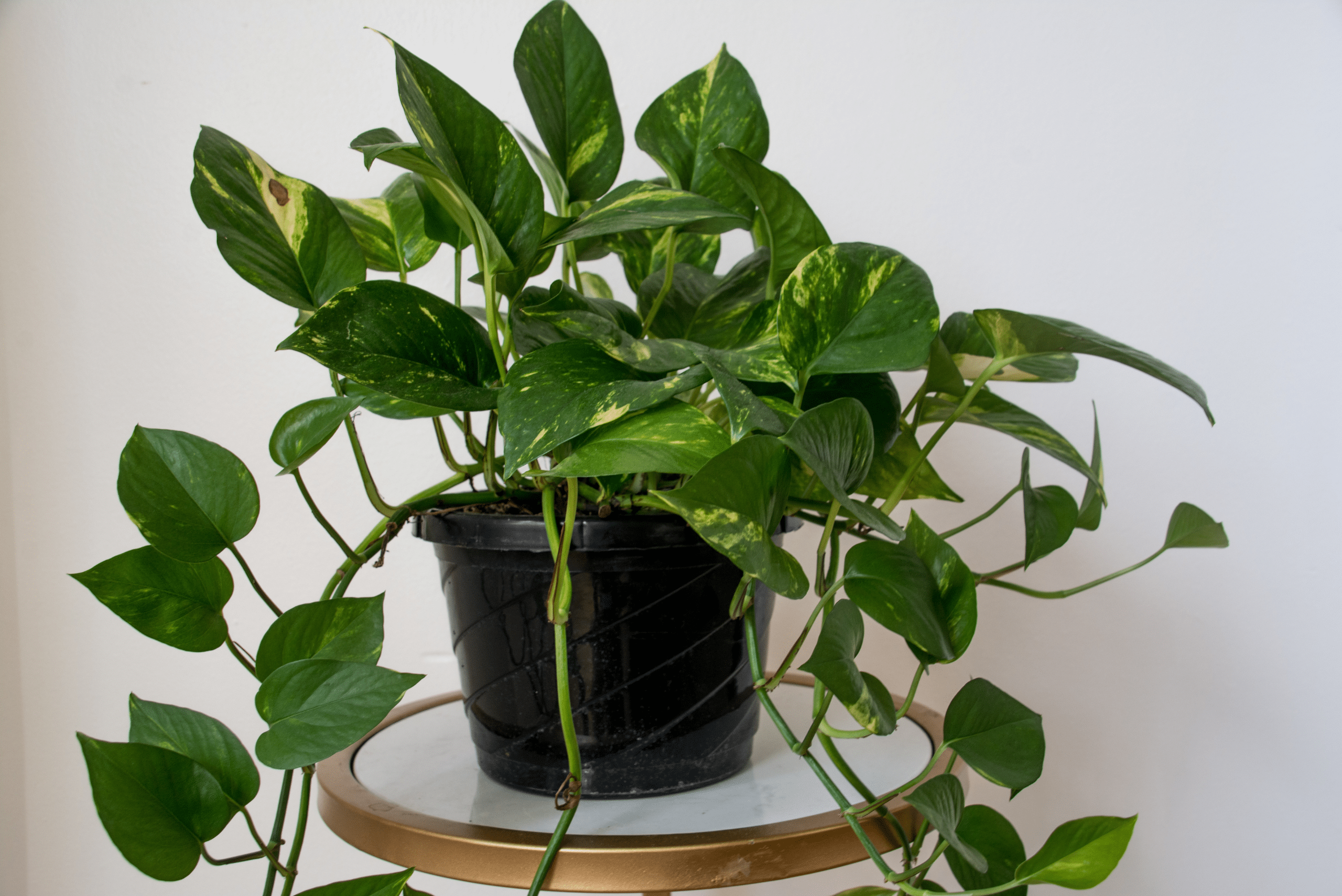
This is one of the easiest answers and a favorite of those who enjoy vining plants. It requires little light and is generally low maintenance. If you are completely new to the world of vining plants and don’t know where to start, this is one of the best to choose.
They grow pretty quickly and can do with some pruning. That said, they don’t require much in the way of upkeep and you don’t even have to get all that specific about their growing conditions to see them reach full size. With a little bit of control, you can keep both size and shape precisely how you want them.
Water: water when dry
Light: low to bright indirect light
Toxicity: toxic to pets
Mature Size: Vines can grow as long as 12 feet
2. Heartleaf Philodendron
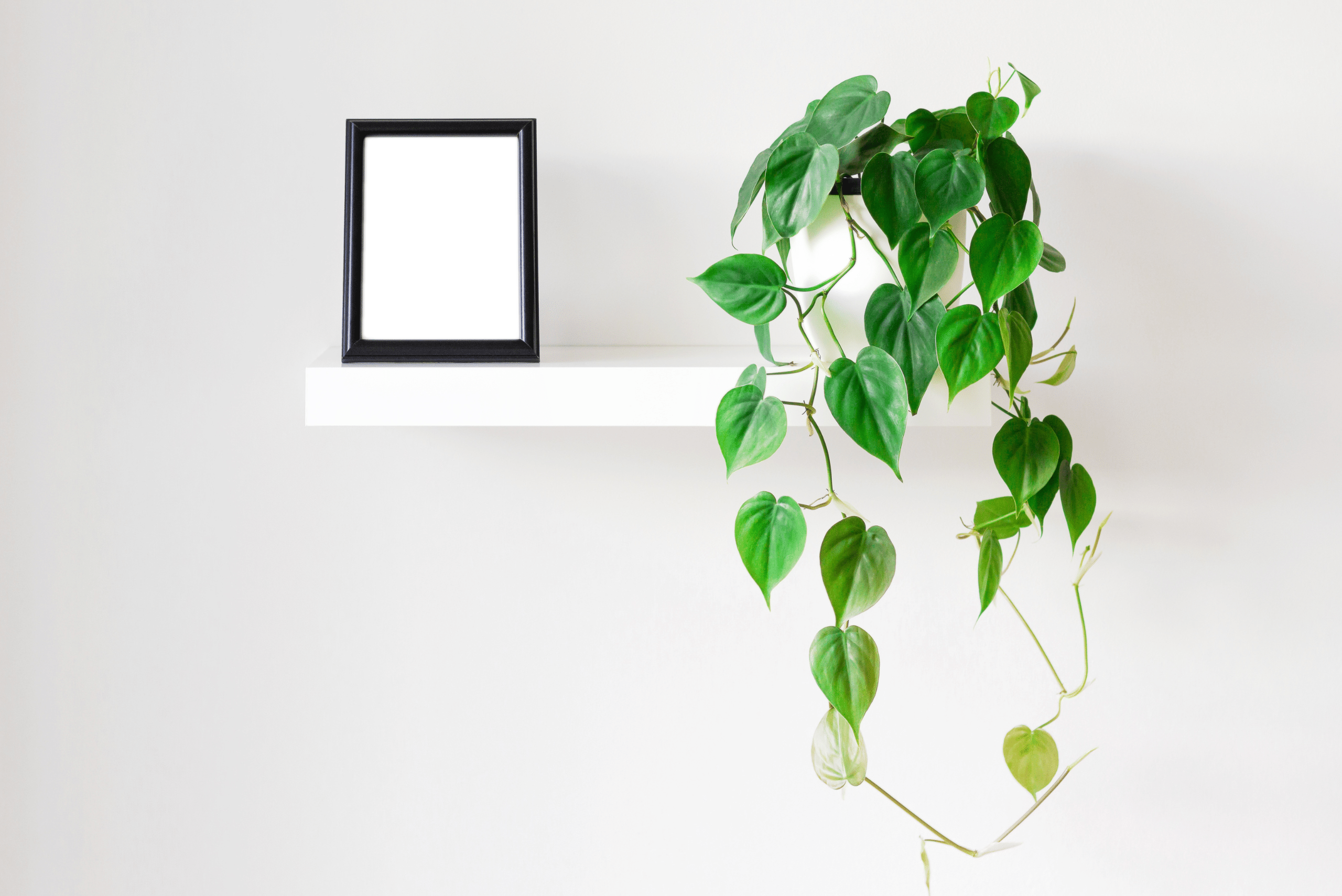
There are more than a few philodendrons on the list and with good reason. One of the most common is this, the heartleaf philodendron. That is mostly due to the fact that it is very low maintenance, making it an excellent choice for an indoor vining plant.
It is also a fast-growing plant, reaching up to 10 feet at full maturity. Not only that, but it looks great in just about any space that you put it in. It can hang, go on a shelf or bookcase; really anywhere that the vines are free and able to drape down.
Water: water when dry
Light: low to bright indirect light
Toxicity: toxic to pets
Mature Size: vines can grow as long as 10 feet
3. Brasil Philodendron
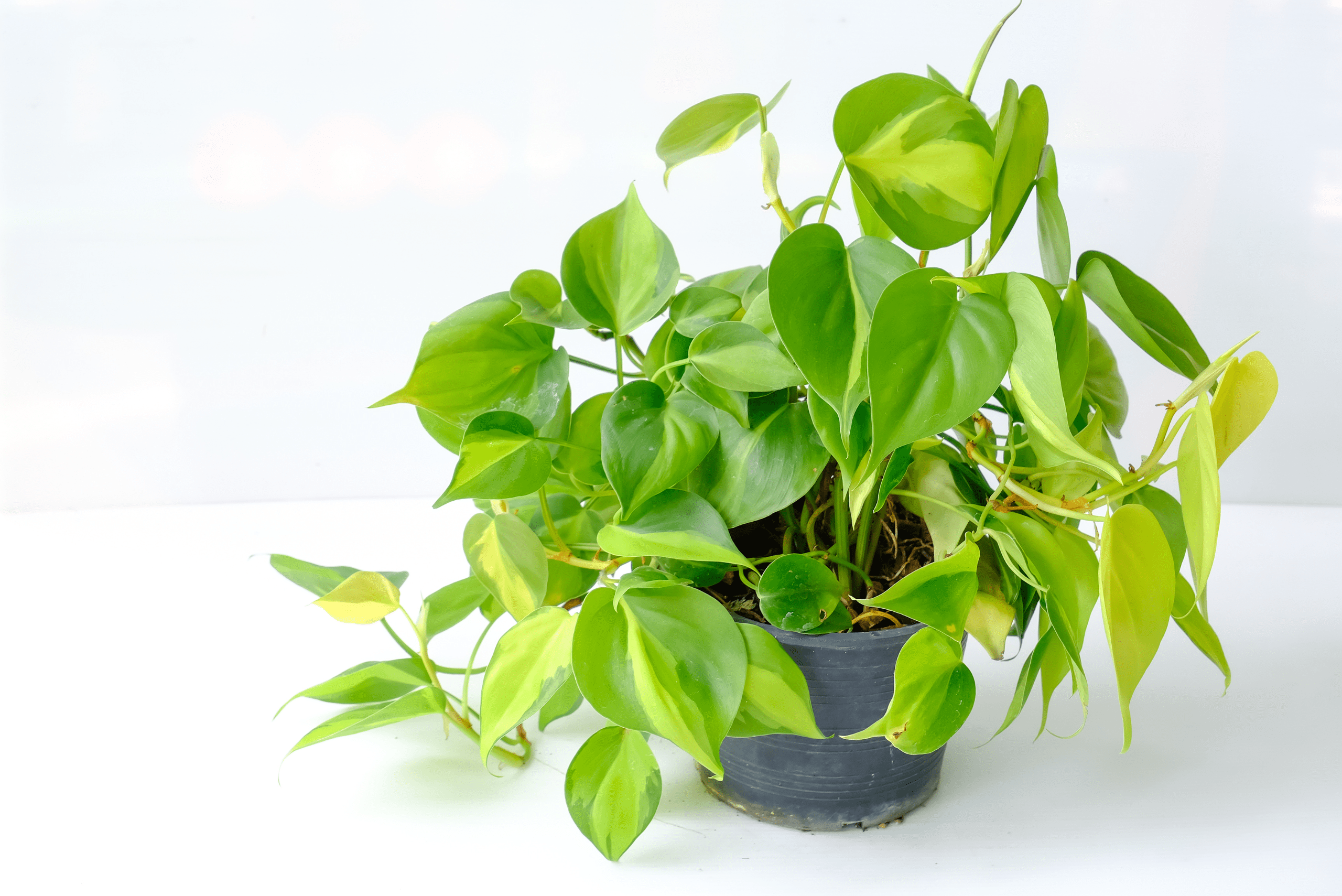
What you may not have known is that the brasil philodendron is actually a cultivator of the aforementioned heartleaf philodendron. The brasil philodendron has a beautiful light to medium green coloring all throughout its foliage.
The cool thing is that its care is right about the same as it is for the heartleaf variation. It does pretty well no matter where you put it so long as it has room to drape down. Keep in mind that the more light it gets, the more vigorous the coloring will be, so make sure to avoid any low-light spots when you can in order to get the best aesthetic out of the brasil.
Water: water when dry
Light: medium to bright indirect light
Toxicity: toxic to pets
Mature Size: vines can grow as long as 10 feet
4. Philodendron Micans
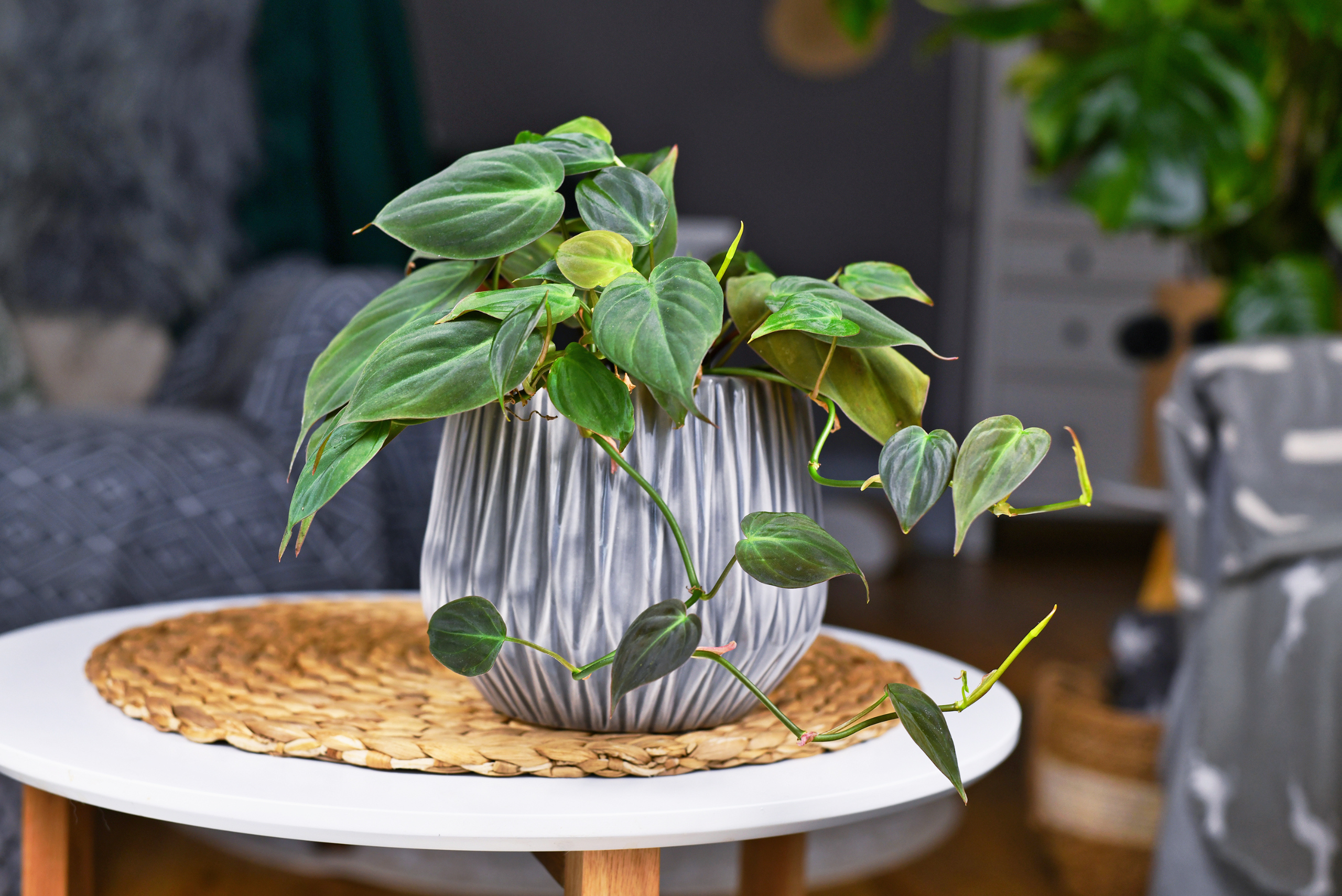
The philodendron micans is one of the more uncommon vining philodendrons in that it has beautiful, deep green leaves that are velvety in texture and can even get a maroon-ish color. They grow pretty fast when the conditions are right but are thankfully quite easy to take care of.
Because they only reach about 5 feet at full maturity, you don’t have to worry about pruning them. If you want, you can prune to shape but mostly just let the tropical vine grow on its own. Make sure to keep it out of reach of pets, though, as it is toxic to cats and dogs.
Water: water when dry
Light: medium to bright indirect light
Toxicity: toxic to pets
Mature Size: vines can grow as long as 5 feet
5. Mini Monstera
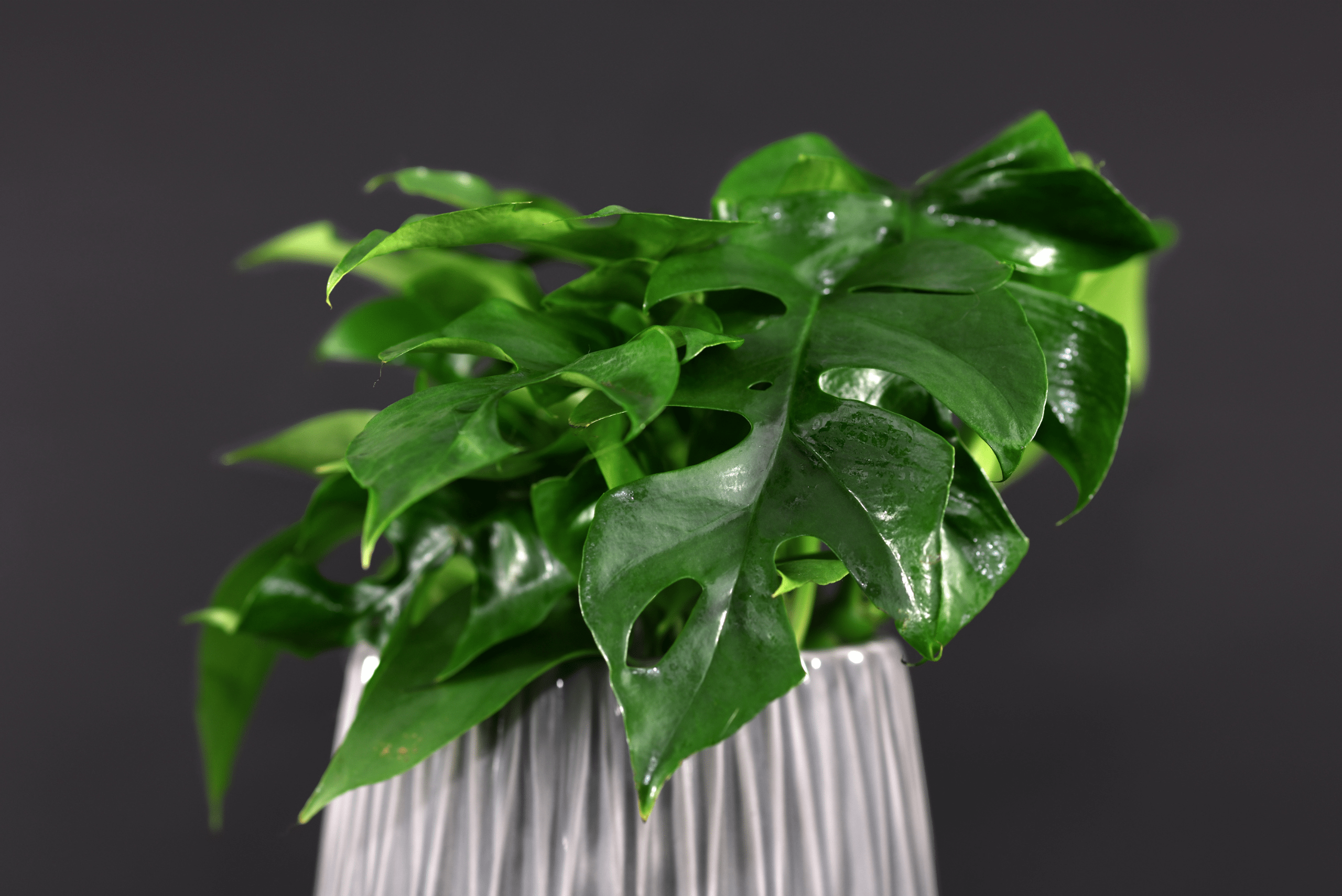
A beautiful little plant, it is a variation of the main monstera plant. But the funny thing is that it isn’t actually in the Monstera genus. Because of a similar growth pattern and care techniques, it is pretty similar to the monstera deliciosa.
They are great for small apartments, especially since they have the habit of climbing as they grow, shooting upwards instead of outwards or vining down. Because of their larger size (up to 12 feet), they require a bit of pruning to keep them from getting too long to manage.
Water: water when dry
Light: bright indirect light
Toxicity: toxic to pets
Mature Size: vines can grow as long as 12 feet
6. Satin Pothos
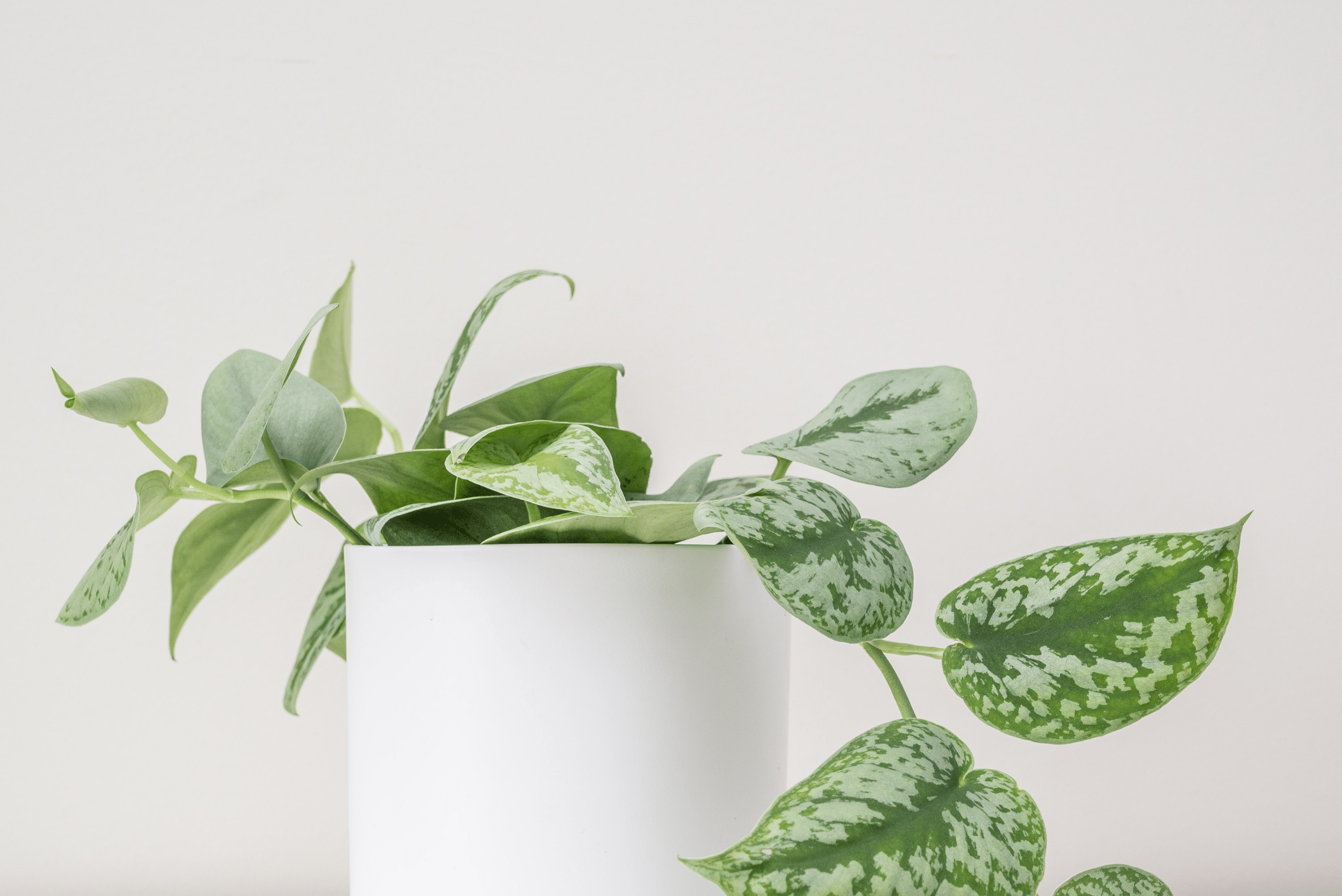
Though it is commonly referred to by the satin pothos name, isn’t actually a pothos. No, it is a Scindapsus variety with thick, large leaves that have a velvety texture to them. It also has beautiful splotches of silver all throughout.
One of the most visually appealing of the vining plants on this list, it is a slow grower so you only have to prune sporadically to keep it from growing to its full maturity. Even better, the care requirements are simple to follow and it should do well no matter where you place it.
Water: water when dry
Light: medium to bright indirect light
Toxicity: toxic to pets
Mature Size: vines can grow as long as 10 feet
7. Scindapsus Pictus ‘Argyraeus’
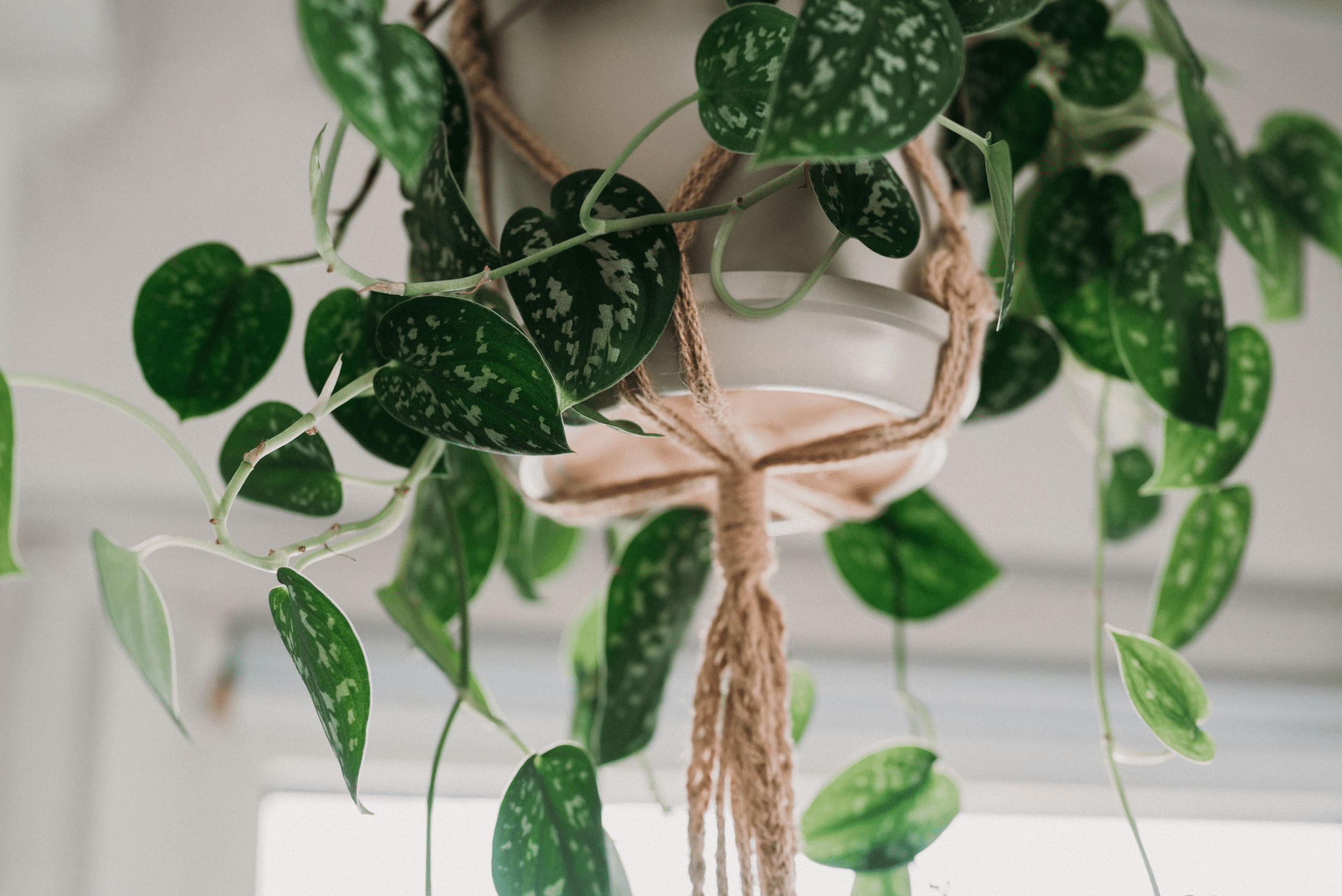
There are more than a few varieties of Scindapsus out there, but this is one of the more visually appealing. It is the smaller version of the Scindapsus pictus ‘Exotica’ but it grows a lot faster than its counterpart.
With green, velvety leaves that have small silver spots all over them, they are brighter than some of their counterparts. It tends to do its best in brighter light, though it must be indirect. Because it only grows to 5 feet at maturity, you don’t need to do any maintenance or pruning going forward.
Water: water when dry
Light: medium to bright indirect light
Toxicity: toxic to pets
Mature Size: vines can grow as long as 5 feet
8. Scindapsus Treubii ‘Moonlight’
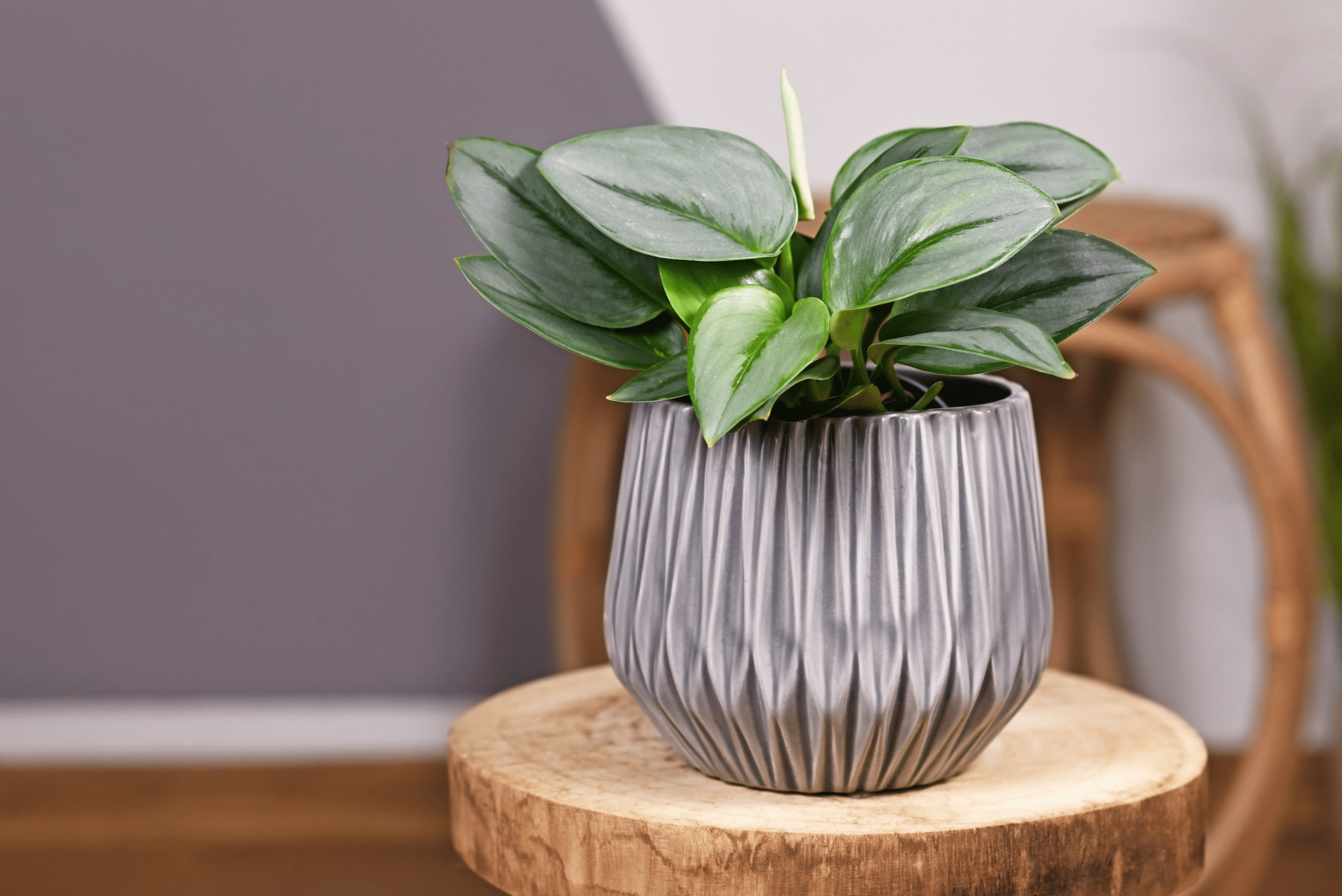
Another from the Scindapsus family. This Scindapsus is of the slow-growing variety and tops out at just 4 feet, proving to be a cute little variation to some of the longer vining plants. It has a waxy feel to the leaves with an almost silver hue to it.
They do well in hanging planters but are also suitable climbers. They are not only toxic to pets, but to humans as well. Make sure to keep them out of the reach of cats and dogs as well as small children for their safety.
Water: water when dry
Light: bright indirect light
Toxicity: toxic to pets and humans
Mature Size: vines can grow as long as 4 feet
9. Betel Leaf Plant
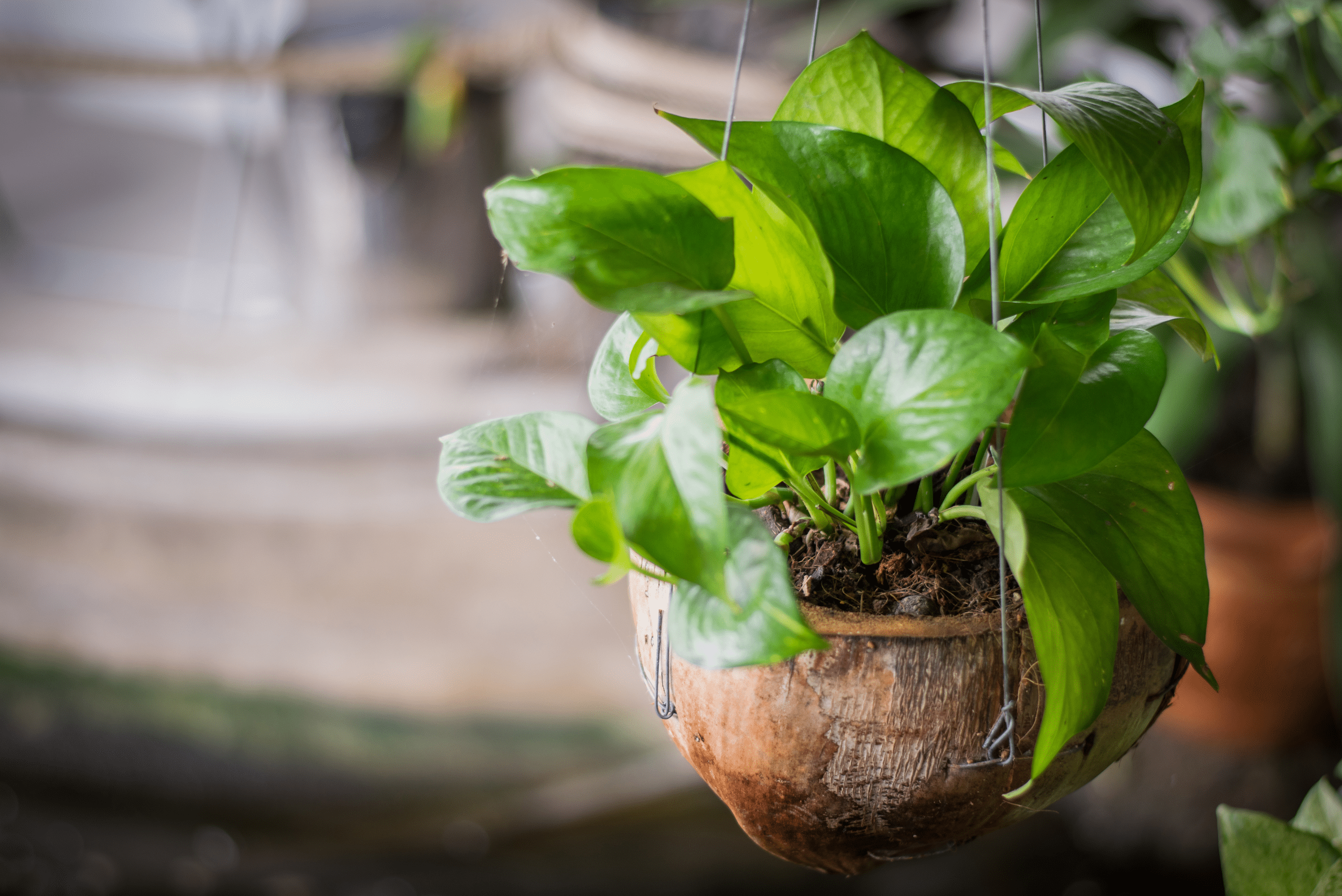
Though there are several different types of betel leaf plant, they all share upward growth and pointed, bright green leaves. They love shade, benefitting from indirect light and can also be allowed to vine down in their planter.
Primarily grown in Asia, the betel leaf plant is actually known for its stimulant properties. Just make sure that you keep up on the watering as there are myriad issues that can arise when the soil gets to be too dry for too long.
Water: water when dry
Light: indirect light
Toxicity: toxic to pets and humans
Mature Size: vines can grow as long as 9 feet
10. English Ivy
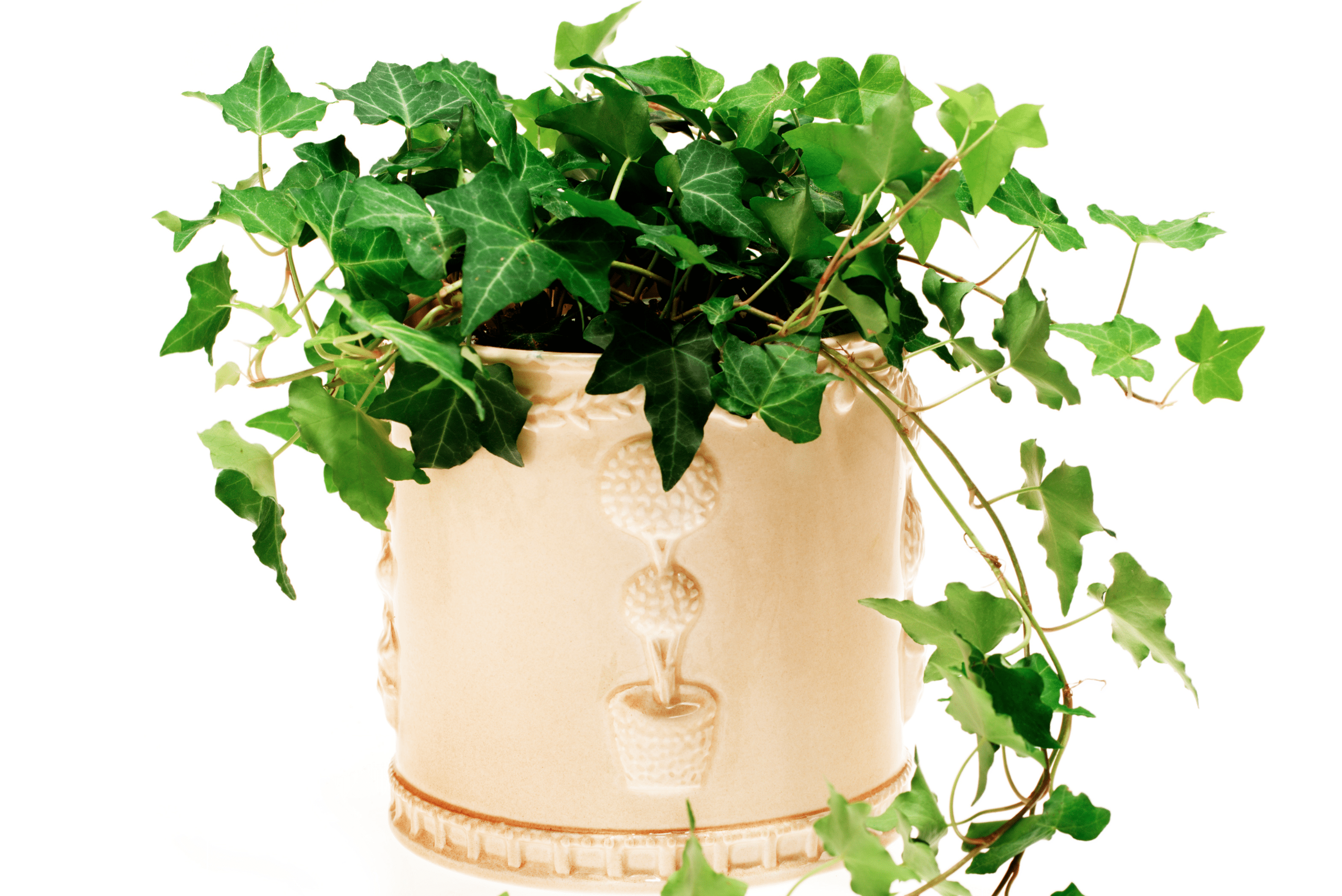
The English Ivy is far and away one of the biggest growers on the list. This fast-growing, luscious plant can get to be way too much for a small space if you don’t keep up with the pruning, hitting 100 feet at its full maturity.
The good news is that it doesn’t require frequent watering but with regular pruning, it is one of the more maintenance-heavy on the list. The leaves are smaller than some of the others, taking on more of an arrowhead shape to them, though they can also be pruned.
Water: water when top inch has dried
Light: bright indirect light
Toxicity: toxic to pets and humans
Mature Size: vines can grow as long as 100 feet
11. String of Nickels
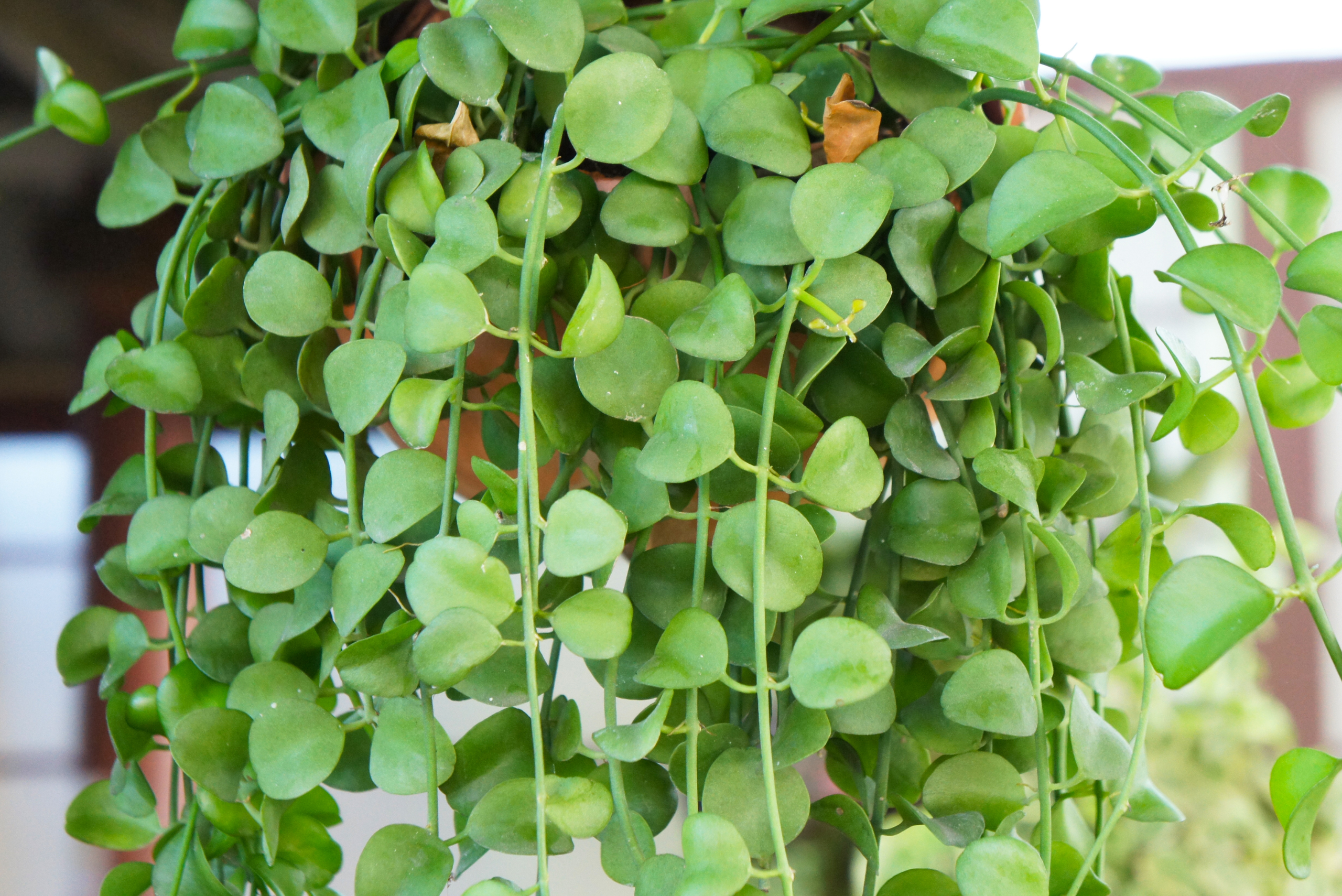
Perhaps the smallest on the list aside from the Scindapsus Treupii, the string of nickels tops out at just 18 inches at full maturity but rarely gets even that long. There are several string varieties with leaves that take on their namesake and the string of nickels is no different.
It is important that they be planted with good drainage and an airy potting mix to give the roots the space that they need to breathe properly. Still, they are the perfect tiny, vining plant for any space and you can implement more than one in a single space.
Water: water when top 2 inches are dry
Light: bright indirect light
Toxicity: non-toxic
Mature Size: vines can grow as long as 18 inches
12. Arrowhead Plant
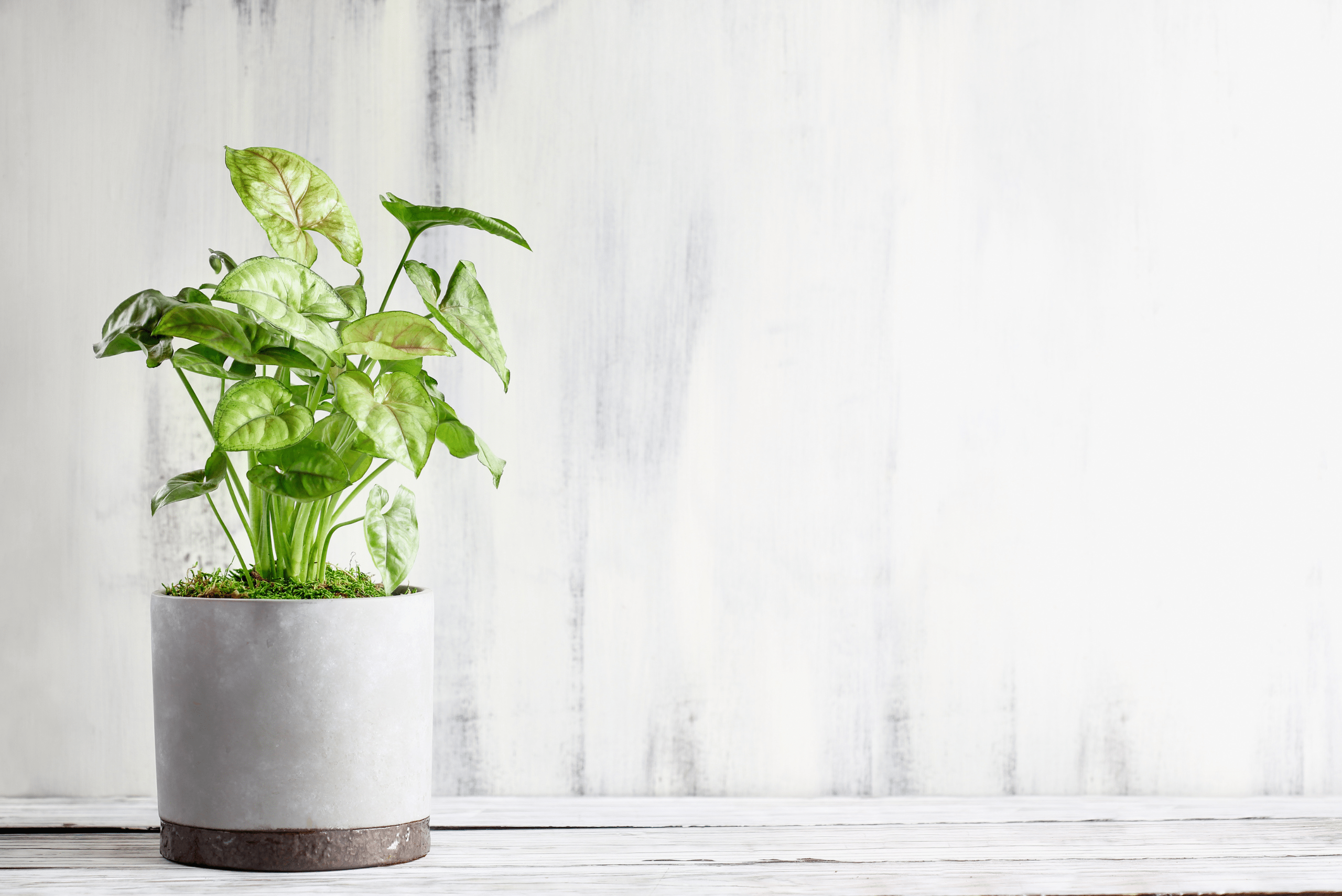
The arrowhead plant is named because, you guessed it, its leaves form an arrowhead shape. With a smooth texture and white permeating the green leaves, it stands out from other vining plants in its aesthetic.
It is also less tolerant to light than a lot of other vining plants, too. They start out compact but can begin to vine and usually look best when they are displayed using hanging planters. They can also act as climbers using a moss pole, just make sure to keep them away from kids and pets as they are toxic.
Water: water when top couple inches are dry
Light: low to bright indirect light
Toxicity: toxic to pets and humans
Mature Size: vines can grow as long as 6 feet
13. Hoya Compacta
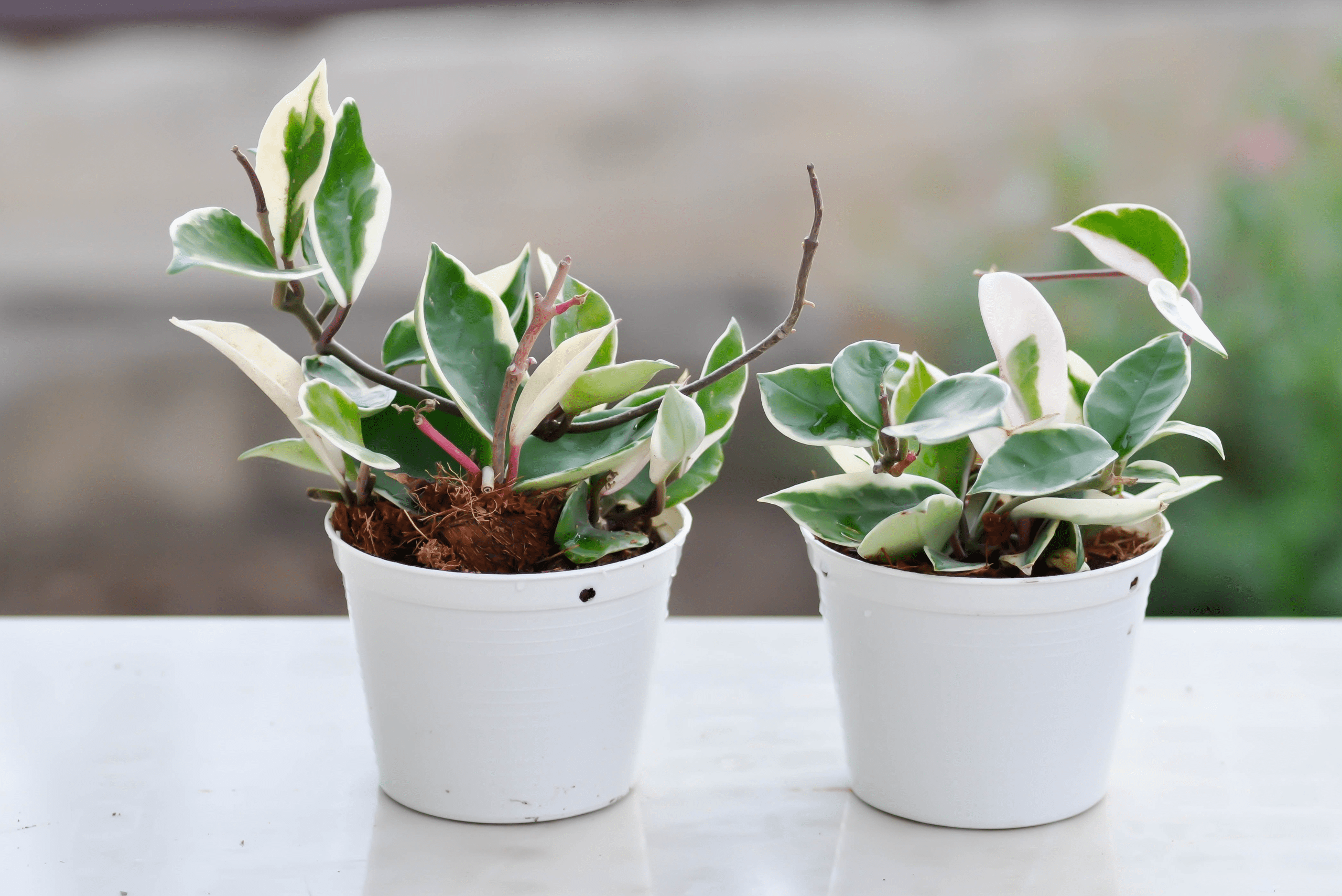
There are actually two versions of the hoya carnosa, with this being the compact version. Its waxy leaves are curled and twisted, making them almost resembling of little ropes. The care is very similar to the hoya carnosa as well. They need a well-draining mix, direct sunlight, and somewhat infrequent watering.
It grows a little slower than the true hoya carnosa but it has some of the most unique foliage that you will find. Looks great in a planter or placed up high where the vines can hang down properly.
Water: Let soil thoroughly dry between watering
Light: bright indirect light
Toxicity: non-toxic
Mature Size: vines can grow as long as 15 inches long
14. String of Turtles
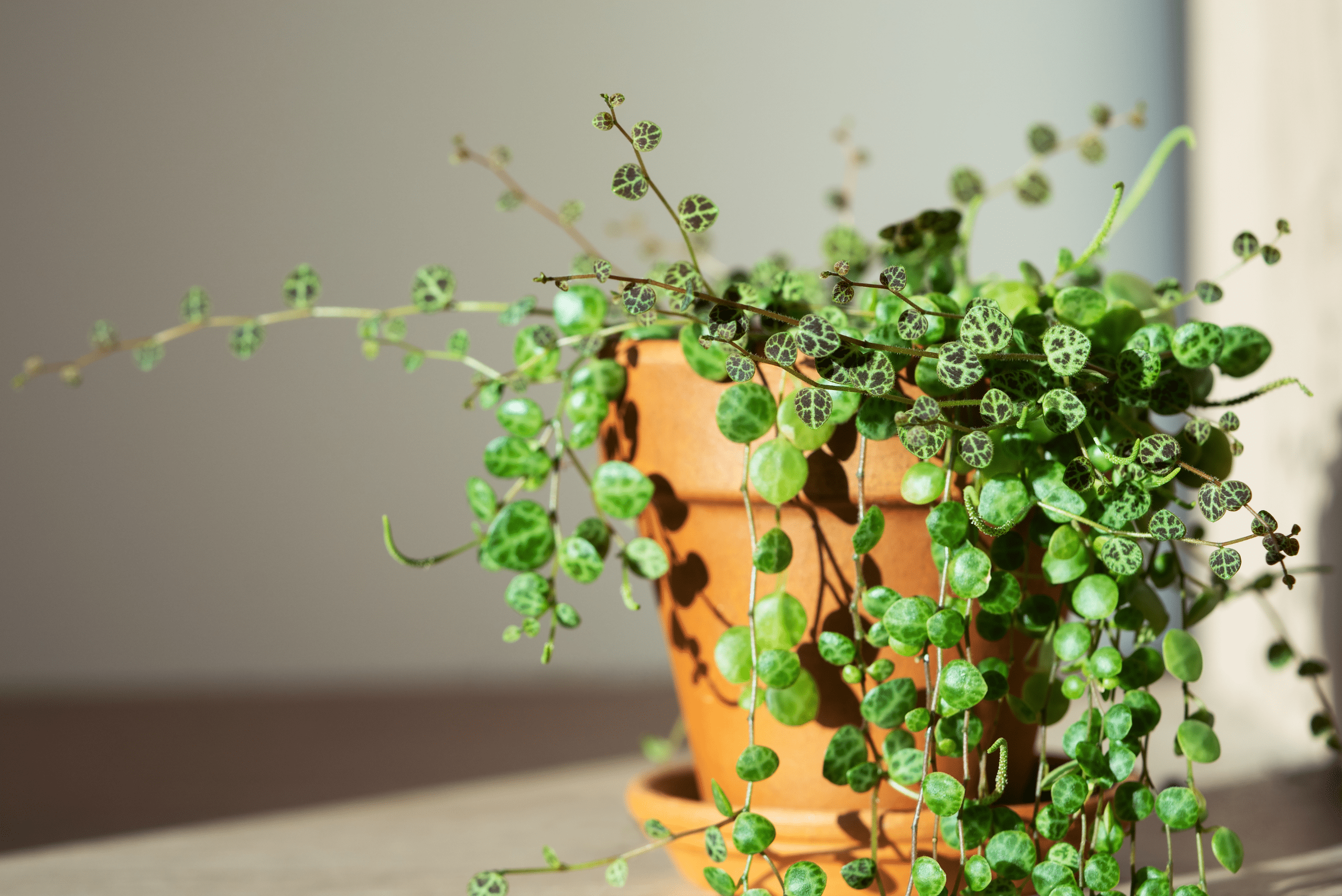
There are several string variations and the string of turtles is probably one of the cuter small vining plants there is. Because of its super small size (the vines only reach 2 feet at full maturity), it is the perfect option to go anywhere in the house. That is especially true considering it is non-toxic as well.
The vines hang over the side of the pot, with the leaves taking the shape of little turtle shells. Like other peperomia strings, it does well in a variety of different lighting conditions and provides you with a low-maintenance option that won’t require much in the way of attention or time.
Water: water when top inch is dry
Light: low to bright indirect light
Toxicity: non-toxic
Mature Size: vines can grow as long as 2 feet
15. String of Bananas
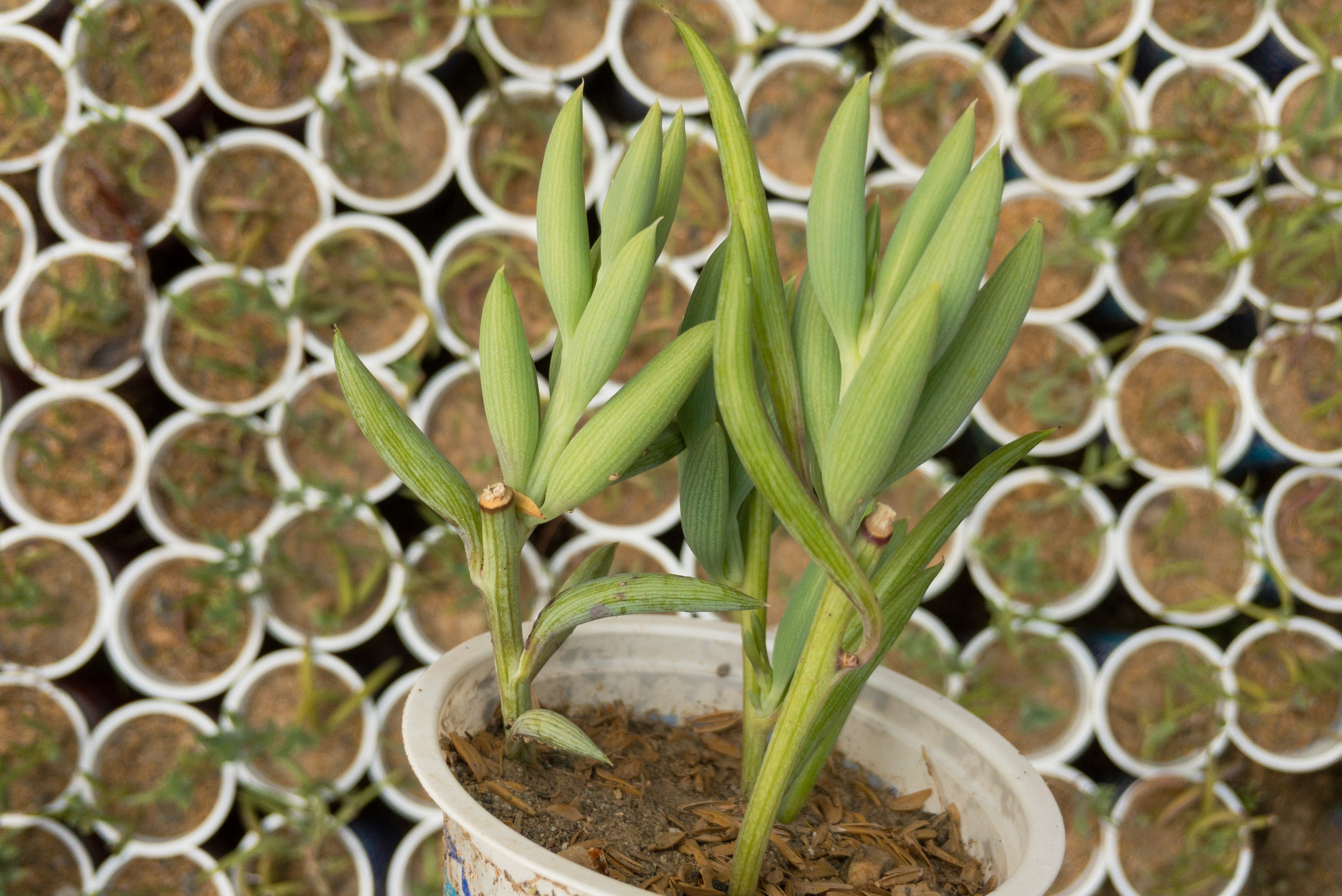
The great thing about any of the “string” plants is that they all look like their namesake. Hearts look like hearts, turtles like turtle shells, and the string of bananas are no different. They are actually close relatives to the string of pearls and are known for being fast growers.
They are also quite a bit easier to care for than the string of pearls, so long as they get 4-5 hours of direct sunlight and the soil can dry out thoroughly between waterings. Keep it out of reach of pets and children, though, because it is toxic.
Water: let soil dry thoroughly between watering
Light: 4-5 hours of direct, bright sunlight each day
Toxicity: toxic to pets and humans
Mature Size: vines can grow as long as 3 feet
16. String of Dolphins
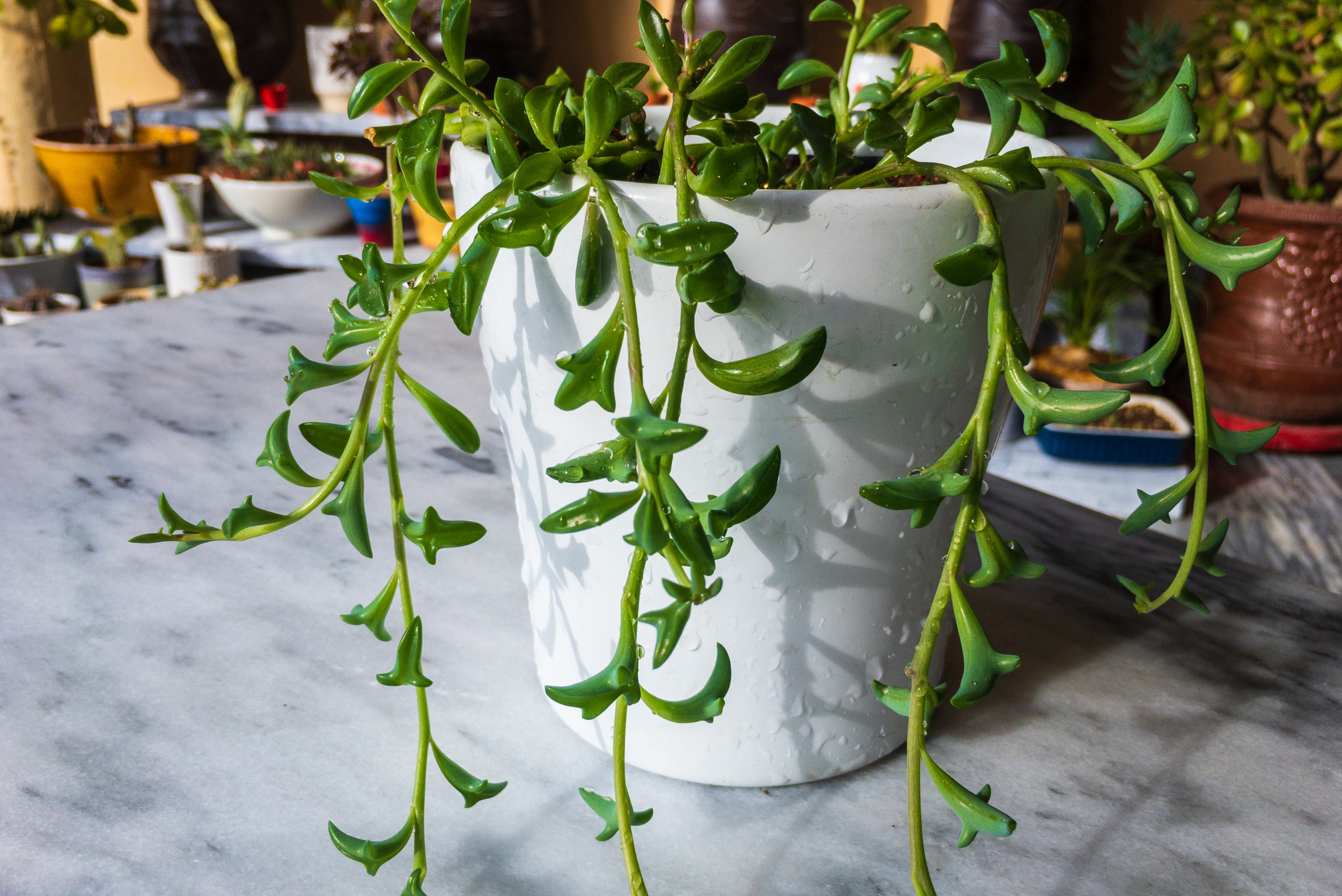
Let’s stay with the string variety, another that is related to the string of pearls. What makes these vines so adorable is that they do closely resemble dolphins leaping into the air. They grow in bunches until spilling out over the side of their container and hanging down over the sides.
They need plenty of direct light but the great thing about the string of dolphins is that they don’t require much watering. Due to its toxic nature, be sure to place it out of the reach of kids and pets.
Water: only requires watering every few weeks
Light: require several hours of direct, bright sunlight per day
Toxicity: toxic to pets and humans
Mature Size: vines can grow as long as 2 feet
17. String of Hearts
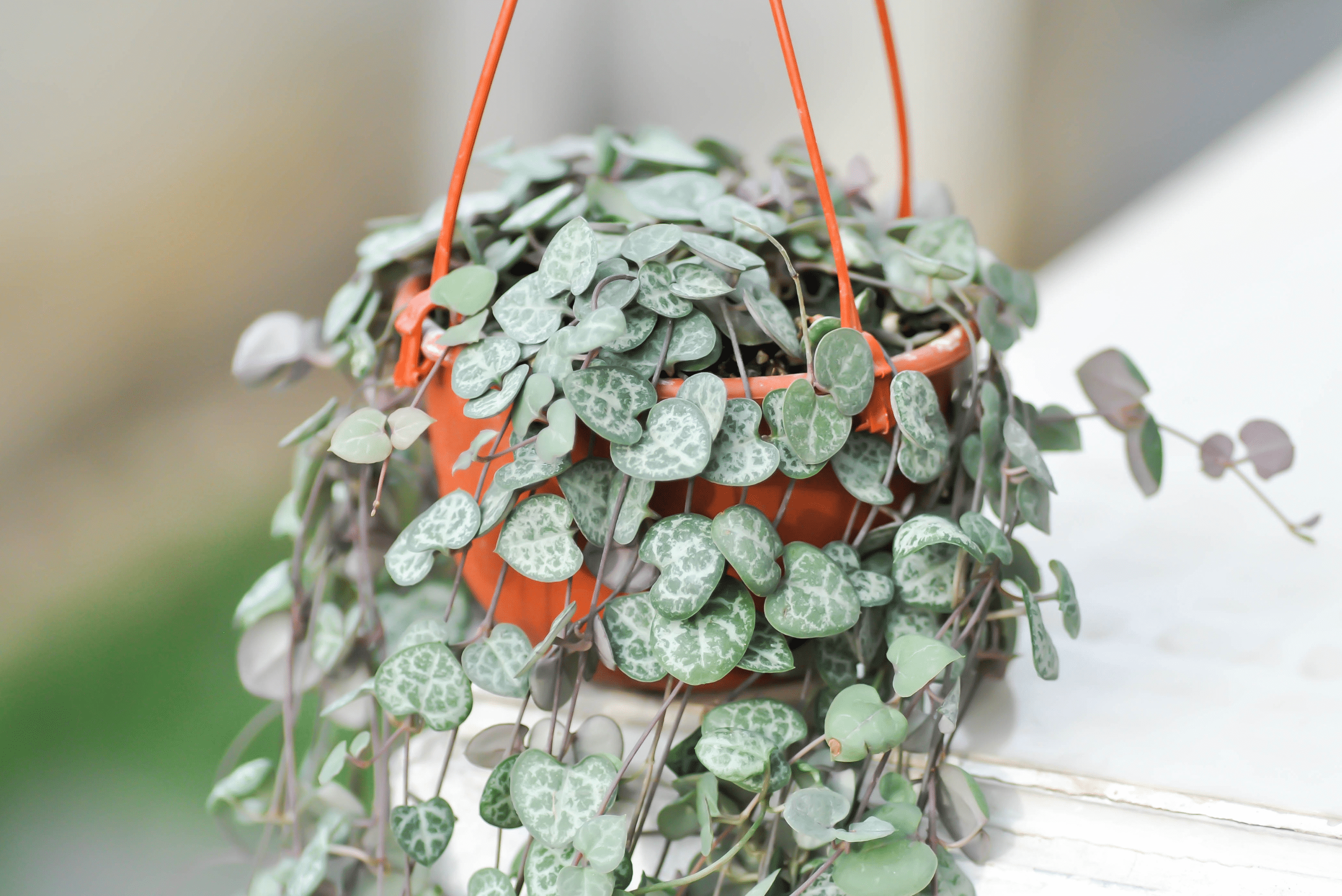
Though the leaves definitely look like hearts, they can also look like dingy lily pads with specs of black and brown adorning them. They also don’t grow so close together as the string of dolphins do, hanging in long strands down the side of their container.
The vines are delicate and small however, so handle them with care. They need lots of bright light throughout the day but only to be watered when the soil has completely dried.
Water: let soil dry between watering
Light: indirect, bright light
Toxicity: non-toxic
Mature Size: vines can grow as long as 12 feet
18. String of Pearls
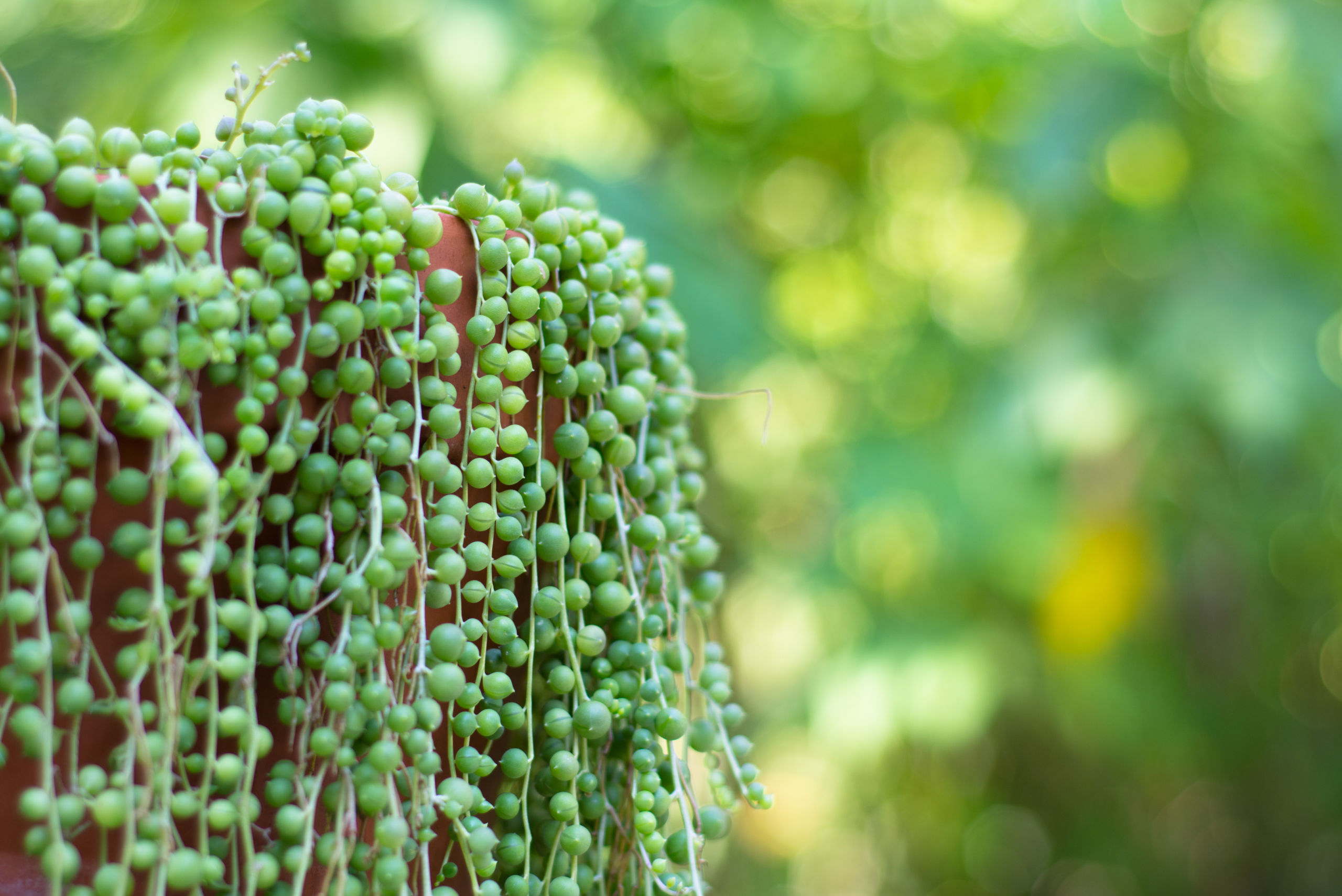
The final in our “string” series, they look more like peas than pearls but that is due to their green hue. They require a lot of sunlight though only need to be watered every few weeks. Because of the small size of the vines, they won’t grow too long, meaning minimal maintenance.
Water: water every few weeks
Light: several hours of direct, bright sunlight per day
Toxicity: toxic to pets and humans
Mature Size: vines can grow as long as 3 feet
19. Monstera Peru
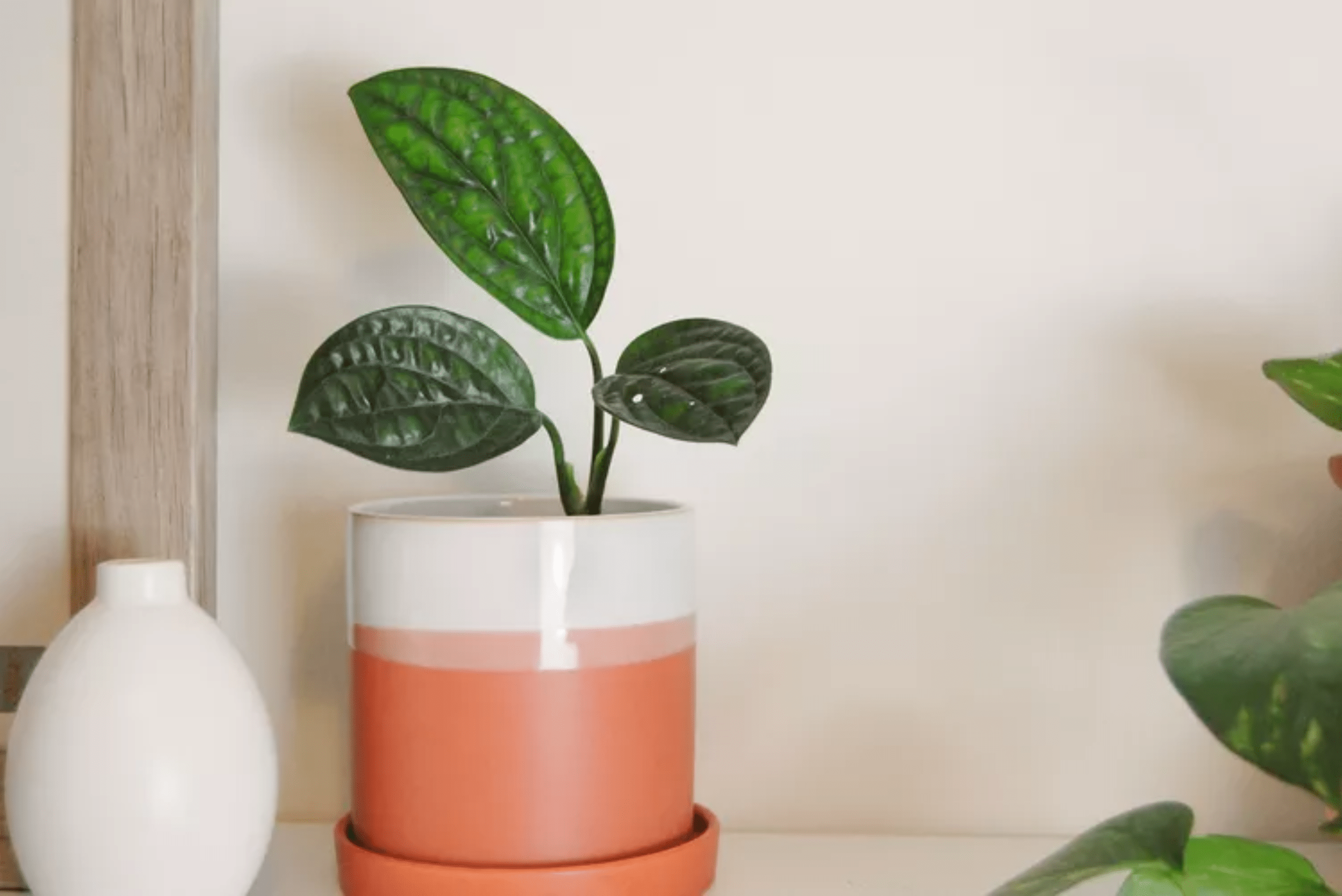
From the monstera family, this is one of the more rare varieties which has bright green, embossed leaves as well as a vining growth. They are harder to find but they are very easy to plant and to care for. Just make sure to put it in a focal spot in your home so that it can get all the light that it needs to properly thrive.
Water: water when dry
Light: medium to bright indirect light
Toxicity: toxic to pets and humans
Mature Size: vines can grow as long as 10 feet
20. Swiss Cheese Plant
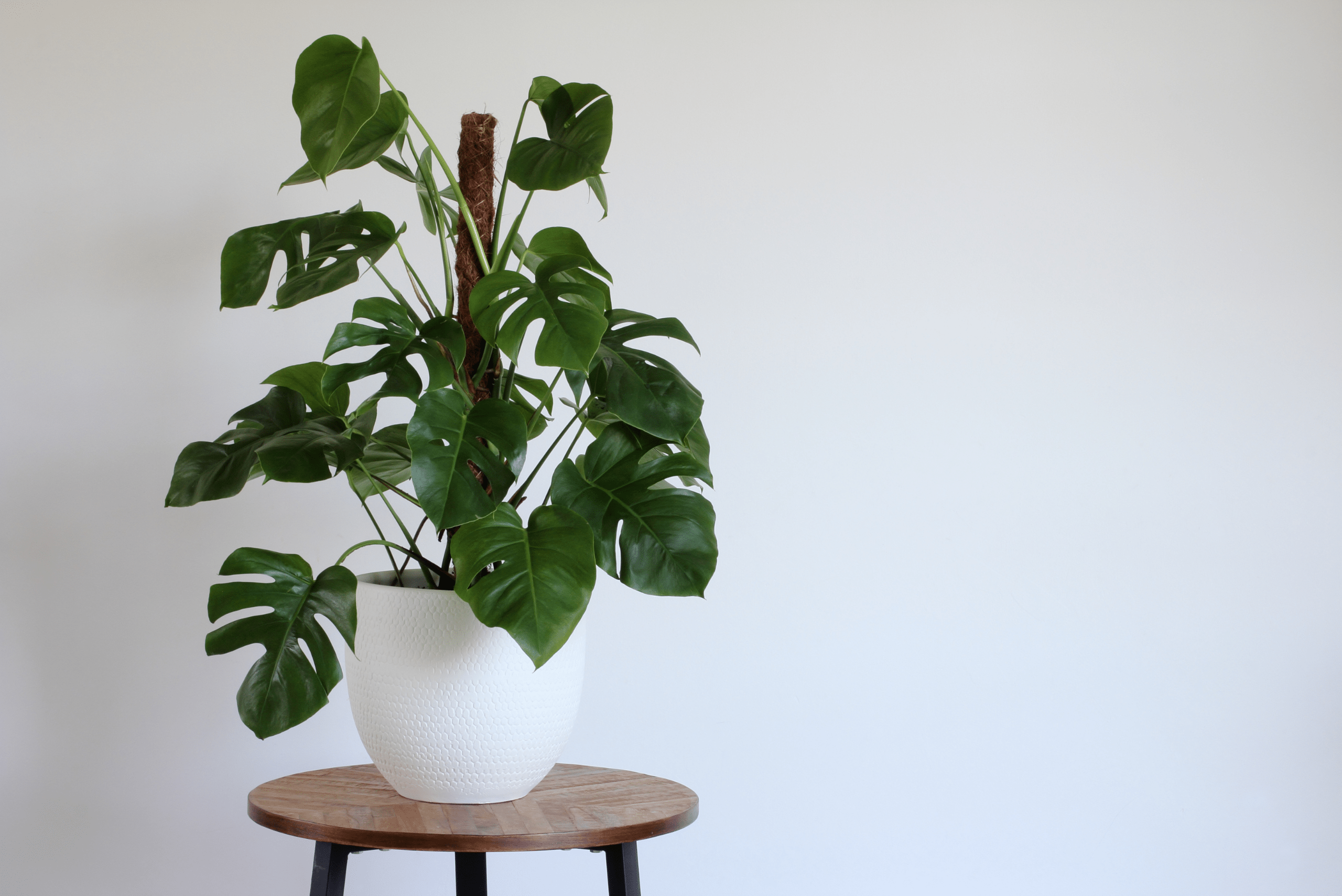
It gets its name due to the various holes that permeate the leaves. It is also right up there among the most popular from the monstera varieties. It has some of the brightest green leaves and a habit of climbing rather than hanging. Because of the length (12 feet) the may require some pruning to keep them in check.
Water: water when dry
Light: medium to bright indirect light
Toxicity: toxic to pets and humans
Mature Size: vines can grow as long as 12 feet
21. Monstera Deliciosa
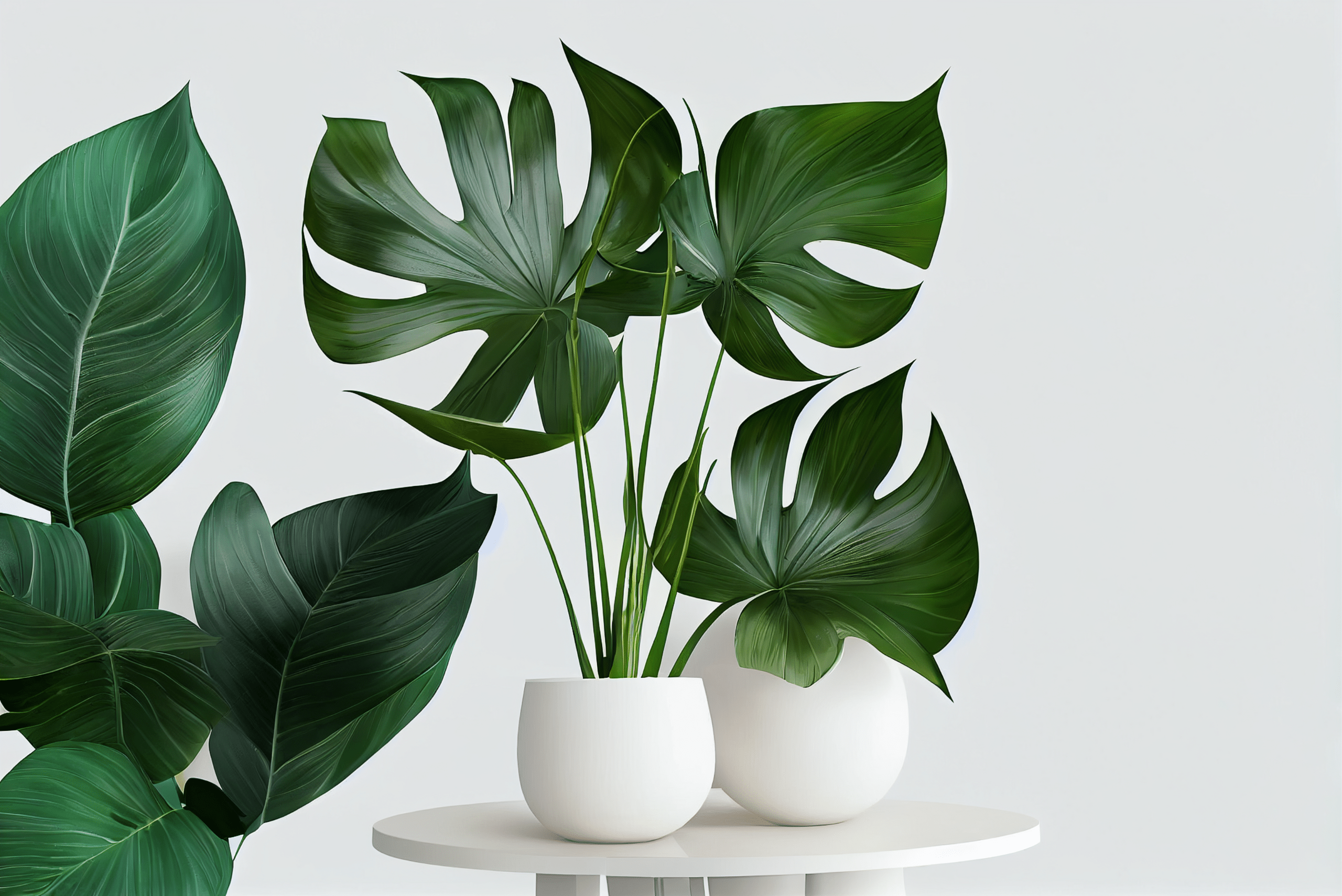
Monstera deliciosa is the OG of the monster clan. It is a low-maintenance plant, perfect for just about any home setting. It has some of the darkest, lushest leaves out there looking similar to the swiss cheese plant in a lot of ways. It is a great beginner plant since it is forgiving and can take some negligence.
Water: water when dry
Light: low to bright indirect light
Toxicity: toxic to pets
Mature Size: vines can grow as long as 10 feet









